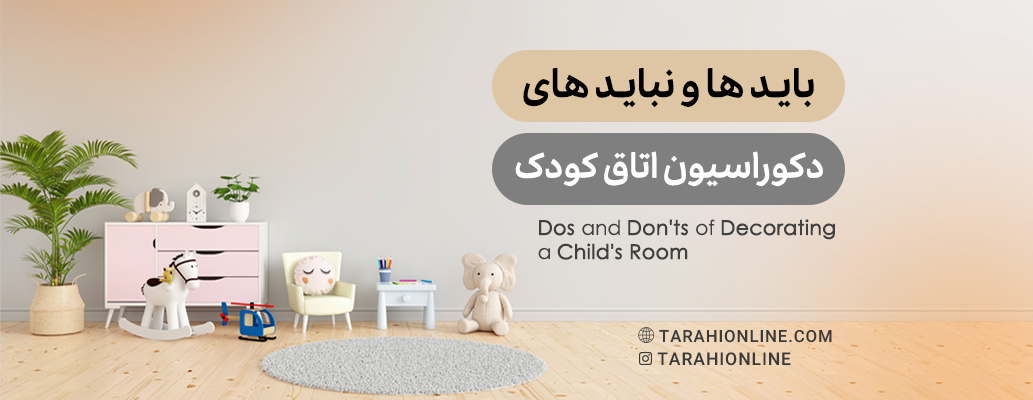
Decorating a child's room is a delightful yet challenging task. The room should be a safe haven for your child, filled with inspiration and comfort. Here’s a comprehensive guide to the dos and don’ts to help you create a perfect space for your little one.
Dos
-
Prioritize Safety
Safety should always be the top priority when decorating a child's room. Ensure that all furniture is sturdy and secure. Anchor bookshelves and heavy furniture to the walls to prevent tipping. Use safety gates if necessary and cover electrical outlets with safety covers.
-
Choose Child-Friendly Paint
Opt for non-toxic, low-VOC (volatile organic compounds) paints. These are safer for children and better for the environment. Choose soothing colors like blues, greens, or pastels, which are known to create a calming atmosphere.
-
Create a Theme
Themes can make a child’s room fun and exciting. Whether it’s their favorite cartoon character, a jungle safari, or a space adventure, incorporating a theme can stimulate a child’s imagination. Use themed beddings, wall decals, and accessories to tie everything together.
-
Incorporate Storage Solutions
Kids have a lot of toys, books, and clothes, which can create clutter. Incorporate plenty of storage solutions such as bins, baskets, shelves, and toy chests. This not only keeps the room tidy but also teaches your child the importance of organization.
-
Use Multi-Functional Furniture
Invest in multi-functional furniture to maximize space. Beds with built-in storage, convertible cribs, and desks that double as craft tables can save space and provide multiple uses as your child grows.
-
Create a Reading Nook
Encourage a love for reading by creating a cozy reading nook. Use a small bookshelf, a comfortable chair or bean bag, and good lighting. This can become a quiet retreat where your child can dive into their favorite books.
-
Ensure Proper Lighting
Good lighting is essential in a child’s room. Use a mix of ambient, task, and accent lighting. Install dimmer switches to control the lighting mood. Nightlights can also be comforting for young children who are afraid of the dark.
-
Personalize the Space
Make the room special by incorporating personal touches. Display your child's artwork, use monogrammed items, or create a gallery wall of family photos. This makes the room feel unique and personal to your child.
-
Incorporate Soft Furnishings
Use soft furnishings like rugs, cushions, and throws to add warmth and comfort. Choose materials that are easy to clean and durable, given the high likelihood of spills and messes in a child's room.
10. Make It Adaptable
Children grow quickly, and their tastes change just as fast. Create a room that can adapt as your child grows. Use neutral bases for walls and larger furniture, and add pops of color or themed accessories that can be easily changed.
Don’ts
-
Avoid Overly Trendy Designs
While it's tempting to go for the latest trends, remember that trends change rapidly. Opt for timeless designs that can grow with your child. This will save you from frequent redecorating and ensure that the room remains functional for years.
-
Don’t Clutter the Room
Avoid filling the room with too many items. A cluttered room can be overwhelming and make it difficult for your child to concentrate. Keep it simple with just a few well-chosen pieces of furniture and decor.
-
Steer Clear of Fragile Items
Avoid using fragile decor items that can break easily. Children are naturally curious and may accidentally knock over delicate items. Stick to sturdy, child-friendly decor that can withstand a bit of rough play.
-
Don’t Ignore Your Child’s Preferences
Involve your child in the decorating process. Ignoring their preferences can lead to dissatisfaction. Let them choose colors, themes, or accessories. This will make them feel valued and ensure that they love their room.
-
Avoid Dark, Dull Colors
While dark colors can be stylish, they are not always suitable for a child’s room. They can make the space feel smaller and less inviting. Opt for brighter, more vibrant colors that reflect a cheerful and playful atmosphere.
-
Don’t Forget About Flooring
Hardwood floors can be beautiful, but they can also be hard and cold. Consider adding rugs or carpets to create a softer, warmer surface for play. Choose options that are easy to clean and maintain.
-
Avoid Heavy, Unsecured Furniture
Heavy furniture can pose a risk if not secured properly. Avoid placing large, unsecured items that could topple over. Always anchor heavy furniture to the wall to prevent accidents.
-
Don’t Skimp on Storage
Underestimating the need for storage can lead to a cluttered room. Ensure there is ample storage for toys, clothes, and books. Having a place for everything will help keep the room organized and teach your child to tidy up after themselves.
-
Avoid Busy Patterns
While patterns can add interest, too many busy patterns can be overwhelming. Balance patterns with solid colors to create a harmonious look. This will also make the room feel more spacious and serene.
10. Don’t Neglect Functionality
While aesthetics are important, functionality should not be sacrificed. Ensure that the room layout allows for easy movement and accessibility. Arrange furniture in a way that makes sense for the activities your child will engage in, such as playing, studying, and sleeping.
Decorating a child’s room is a wonderful opportunity to create a space that fosters growth, creativity, and comfort. By following these dos and don'ts, you can design a room that is both practical and delightful for your child. Remember to prioritize safety, incorporate plenty of storage, and involve your child in the process to make the room truly their own. Contact us for further consultation and services.